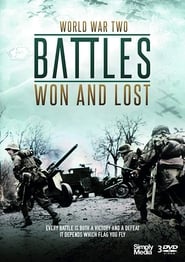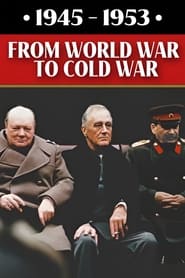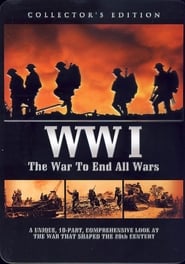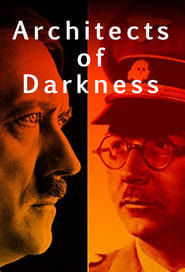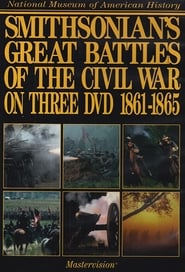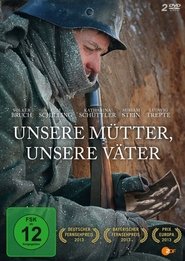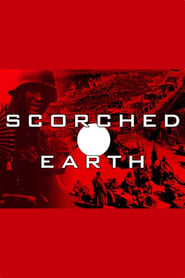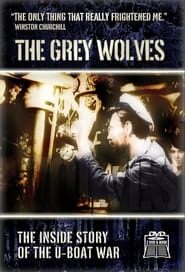Popular War Politics TV Series on Tubi TV - Page 6
-
The Sound and the Fury
2025
star 6From the Japanese invasion of Manchuria to the siege of Stalingrad, and from the attack on Pearl Harbor to the battle of El Alamein, the events of the Second World War are presented on a 'planet level' to place it on a truly global scale -
World War II: Battles Won and Lost
2017
This sweeping World War II series examines the outcome of battles fought in every major theater. It shows that these battles were decided by strategy and by which armies could capitalize on the terrain or gain better access to supplies. Whether waged by the Allies or by Hitler and the Axis powers, victory or defeat could determine possession of territory, resources, or the will to go on fighting. -
WWII Air Crash Detectives
2014
star 2.5Garth Barnard has a lifelong passion and unshakeable resolve to investigate how thousands of young Airmen from the Second World War died in catastrophic air accidents and training crashes. -
1945-1953: From World War to Cold War
2017
star 8.5At the outset of the Yalta Conference on February 4, 1945, the «Big Three» were all optimistic: victory was in no doubt, and the accord that they had achieved seemed likely to preserve the values they had fought for. However, in just a few months, nothing would remain of this agreement apart from irreconcilable differences. United in war, the Allies would reveal themselves as divided and rivals in peace. How can such a rapid failure of a real effort at entente be explained? With the Yalta Conference in 1945 to 1953, discover a new world order drawn up by three men, looking for a lasting peace... that would lead inevitably to the Cold War. Combining archive footage, photographs, original letters and unique testimonies, these two episodes revisit this crucial period in History. A full immersion into postwar years and an emerging new world order. -
Warbirds of World War II
1996
From the Battle of Britain to the Dresden bombings, some of the most intense combat of World War II occurred in the airspaces over Europe. This multi-volume box set offers a comprehensive account of the aircraft that helped bring the Allies to victory, including the B-17 Flying Fortress, the B-24 Liberator, the P-51 Mustang, and many more. -
Battleground Vietnam: War In The Jungle
2005
The Vietnam War was one of the worst horrors of the second half of the 20th century and the causes behind it continue to baffle people to this day. How did it start? What were the justifications for America's involvement in Nam? Could it have been avoided altogether? Though it is long over, the Vietnam War will always remain fresh in the minds of the men who fought and the millions who lived through a decades-long conflict right in their backyard. Battleground Vietnam: War in the Jungle covers it all from beginning to end with more than six hours of original footage that brings the battle closer to home than ever. -
Rescue Warriors
2005
Rescue Warriors
2005
Go inside the intense training to become a USAF Pararescue Jumper. Meet the trainees and be there as they endure one of the longest and toughest special operations training courses in the world! Find out who will make it through so "That Others May Live." -
WWI: The War to End All Wars
2008
WWI: The War To End All Wars is a unique, 10-part, comprehensive look at the war that shaped the 20th Century. Through rare, actual battle footage and rare veteran interviews, The War To End All Wars takes you from the assassination of the Austrian Arch Duke in 1914, to the final desperate battles of 1918. Unique and stunning, you will go-over-the-top on the Western Front and witness the carnage in Russia. You'll take to the skies in the world's first air war and ride with the legendary Lawrence of Arabia. This is more than a historical or military account of WWI, it is a riveting and personal account of a defining moment in world history. Never before in the history of the world had so many countries fought on so many far-flung battlefields. Never had so many soldiers lost their lives. Never had there been such an unending hell-on-earth. Never has there b such a remarkable look at 'The War to End All Wars'. -
U-Boats Hitler's Sharks
2009
From the beginning of the Second World War the sea became a vitally important scene of conflict. Great Britain relied on receiving supplies by sea and, therefore, a total blockade of the United Kingdom was one the main objectives of Hitler's Germany. The British government was forced to maintain a strategy of antisubmarine warfare throughout the conflict, while the Royal Navy sought to interrupt the Third Reich's maritime traffic. In these circumstances the submarine became an important weapon of war. Headed by Karl D nitz, who would later succeed Hitler as Head of State, the German U-boats gained the initiative in the sea war and from the beginning launched all-out attacks against shipping en route to Great Britain. One of the great unanswered questions of the war is what would have happened if Hitler had granted the numerous requests made by D nitz for more submarines? -
Architects of Darkness
2017
Six one hour episodes each focusing on a key individual that traces the trajectory and design of Hitler’s thousand year Reich. From the beer halls of Munich to the horrors of the Final Solution, these individuals were truly Architects Of Darkness of the Nazi Third Reich. -
Smithsonian's Great Battles of the Civil War
1994
This critically acclaimed television and video series from the National Museum of American History is a sweeping and compelling look at the war's military, political and social history. Each episode features dramatic reenactments of important campaigns; first-hand accounts of eyewitnesses and participants read by distinguished actors; period photographs, paintings and artifacts; intriguing expert challenges to traditional historical thinking; original contemporary illustrations; computer enhanced maps; and music of the time. -
Showdown: Air Combat
2008
Showdown: Air Combat
2008
-
Crusade in the Pacific
2004
This richly detailed, visually stunning documentary series covers the entire dramatic saga of World War II in the Pacific. From Manchuria to Hiroshima, the people, armaments, locations and battles of the epic conflict are covered in 20 unforgettable episodes. The Allies' crusade to defeat imperial Japan's bloody expansion featured difficult, heroic fighting at sea, in the air, and on innumerable jungle islands. -
Afghanistan
2019
Afghanistan
2019
The project attempts to understand the causes of the Afghan War (1979-1989) and to provide the most truthful coverage of all its stages. On a cold day on December 12, 1979, a small circle of members of the Politburo of the CPSU Central Committee discussed the situation in Afghanistan. After much hesitation, four people (Leonid Brezhnev, Yuri Andropov, Andrei Gromyko, Dmitry Ustinov) made the fateful decision to send troops into Afghanistan. Thus began the Afghan campaign – the first and only military operation waged by the Soviet Union outside the Warsaw Pact countries, which became the longest and most “forgotten” war in Soviet history. -
Scorched Earth WWII
2016
Scorched Earth WWII
2016
When the Nazis unleashed the 'Blitzkrieg', it was a kind of warfare the world had never witnessed before and immediately upended all traditional ideas of military strategy and tactics. Suddenly Europe and North Africa was reeling from this new type of combat and had to adapt quickly or suffer the consequences of Hitler's evil aims. Now, using ground-breaking graphics and state-of-the-art computer animation, as well as archival footage culled from Allied and Axis sources, the incredible initial successes of Hitler's seemingly unstoppable war machine are revealed and examined. Includes 'Hitler's Big Guns', 'Africa Korps', 'Infantry Firepower' and more! -
The Concise History of WWII
2007
This superb program provides a clear and factual account of the causes, course and consequences of World War II, while also assessing the contribution of particular key leaders, such as Hitler, Churchill, Roosevelt, Mussolini and Stalin. -
The Grey Wolves: Echoes from WWII
2016
Grey Wolves captures life on board a U-boat, from the German perspective. First hand accounts in text, letters, diaries, journals, memoirs, relaying tales of the mundane and the routine, dramatic and heroic; the fear and resilience of every crew member, from Kapitainleutnant to Mechaniker. It is a vivid, brutally realistic portrait of the men who fought and died beneath the surface of the Atlantic in what was, perhaps, the most critical battle of the war. -
Als der Krieg nach Deutschland kam
2006
When American troops started their final invasion of Nazi Germany in February 1945, cameramen were at their side and complied over a thousand reels covering 12 weeks in Germany until the ultimate collapse of the Third Reich including stories on the road from the Bulge over the Remagen Bridge to the Eagle’s Nest. Michael Kloft has selected the most striking scenes for his two-part documentary.
 Netflix
Netflix
 Amazon Prime Video
Amazon Prime Video
 Apple iTunes
Apple iTunes
 Apple TV Plus
Apple TV Plus
 Disney Plus
Disney Plus
 Google Play Movies
Google Play Movies
 Paramount Plus
Paramount Plus
 Hulu
Hulu
 HBO Max
HBO Max
 YouTube
YouTube
 fuboTV
fuboTV
 Peacock
Peacock
 Peacock Premium
Peacock Premium
 Amazon Video
Amazon Video
 The Roku Channel
The Roku Channel
 AMC+
AMC+
 Kocowa
Kocowa
 Hoopla
Hoopla
 The CW
The CW
 Vudu
Vudu
 Starz
Starz
 Showtime
Showtime
 PBS
PBS
 Pantaflix
Pantaflix
 FXNow
FXNow
 Tubi TV
Tubi TV
 Kanopy
Kanopy
 Comedy Central
Comedy Central
 Crunchyroll
Crunchyroll
 Microsoft Store
Microsoft Store
 Redbox
Redbox
 Sun Nxt
Sun Nxt
 ABC
ABC
 DIRECTV
DIRECTV
 Crackle
Crackle
 Fandor
Fandor
 Plex
Plex

